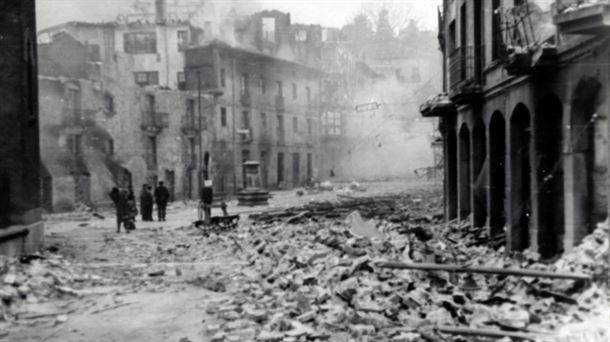
Todos los años en estas fechas queremos conmemorar el Bombardeo de Gernika.
Es un tema que nos toca muy de cerca y no solo porque Urune Hotela esté ubicado a unos 5 Km de Gernika. Nuestras familias fueron supervivientes del bombardeo y es algo con lo que hemos crecido. Recogemos aquí un resumen de lo acontecido.
Este año de pandemia ha provocado que la conmemoración de tan destacada fecha sea sin público pero no por ello se han dejado de organizar actos de sumo interés.
El 26 de abril de 1937, en plena Guerra Civil Española, Gernika, la ciudad símbolo de los vascos y de su ancestral democracia, fue bombardeada por los aviones de la Legión Cóndor alemana.
La tropa auxiliar de los militares sublevados contra la República española, contribuyó decisivamente a la rápida conquista del País Vasco Autónomo (Euskadi) y al triunfo del Régimen de Franco sobre la democracia.
Gernika fue completamente destruida y cientos de personas murieron en una lluvia de bombas, metralla y fuego. El bombardeo de Gernika fue el primer ataque aéreo indiscriminado contra una ciudad indefensa y su población civil, y como tal un anuncio de futuras tragedias que culminaron en la destrucción de Pforzheim, Dresden e Hiroshima.
Gernika se convirtió en símbolo de los horrores de la guerra de nuestra era, plasmado en el famoso cuadro de Pablo Picasso.
Este hecho marcó para siempre la vida de los supervivientes quienes, además, durante cuatro décadas de dictadura franquista estuvieron condenados a guardar silencio sobre la verdad del crimen cometido contra ellos.
(Fuente: La huella humana. GERNIKA GOGORATUZ)
------------------------------------------------------------------------------------------------
Every year on these dates we want to commemorate the Bombing of Gernika.
It is a subject that touches us very close and not only because Urune Hotela is located about 5 km from Gernika. Our families were survivors of the bombing and it is something we have grown up with. We collect here a summary of what happened.
This year of a pandemic has caused the commemoration of such an outstanding date to be without an audience. However, this year also very interesting events have been organized.
On 26 April 1937, at the height of the Spanish Civil War, the Basque people’s sacred town of Gernika, the symbolic home of their ancestral democracy, was bombed by the German Condor Legion, acting as auxiliaries to the rebel army fighting against the Spanish Republic. This devasting attack paved the way for a rapid conquest of the autonomous region of the Basque Country (Euskadi) and to the triumph of Franco´s Regime over democracy.
Gernika was flattened and hundreds died in a hail of bombs, shrapnel and fire. The bombing of Gernika was the first indiscriminate attack against a helpless town and its civil population. As such, it was also an announcement of future tragedies that culminated in the destruction of Pforzheim, Dresden and Hiroshima. Gernika became the symbol of the horrors of war of our age, portrayed in Pablo Picasso´s famous painting.
The horror of that day marked the survivors for ever, and what is more, they were forced to conceal the truth about the crime committed against them during the four decades that General Franco’s dictatorship held power.
(The mark of men. The bombing of Gernika. GERNIKA GOGORATUZ)
--------------------------------------------------------------------------------------------------
Urtero legez, gaurko egun honetan Gernikako Bonbardaketaren urteurrena gogoratu nahi dizuegu. guretzat oso gertuko kontua da eta ez bakarrik Urune Hjotela Gernikatik 5km eskasetara dagoelako. Gure senide eta arbasoek bonbardaketaren zuzeneko lekuko izan ziren eta bizi iraun. Eta gu honekin hasi izan gara eta oraindik bizi dugu.Gertatutakoaren laburpena dakizue ondoren.
Coronavirus urte honetan ekitaldiak jenderik gabe izan dira. Halere, interes handiko ekitaldiak antolatu dira aurten ere.
1937ko apirilaren 26an, Espainiako Gerra Zibila gori-gorian zegoela, Gernika bonbardatu zuten alemaniarren Kondor Legioaren hegazkinek, alegia, euskaldunen hiri saindua, aintzineko demokraziaren sinboloa. Izan ere, Kondor Legioa Espainiako Errepublikaren aurka matxinatutako militarren armada laguntzailea zen. Ekintza hau erabakiorra izan zen, Euskal Herri Autonomoa (Euskadi) arin menperatzeko eta Francoren erregimenak demokraziaren aurka garaitzeko.
Gernika erabat suntsitu eta ehunka bizilagun hil zituzten, bonba, metraila eta suaren ondorioz. Gernikako bonbardaketa babesik gabeko hiri baten eta bere biztanleen aurkako lehen eraso bereizi gabea izan zen. Era berean, izugarrikeria askoren lehen urratsa izan zen. Pforzheim, Dresden eta Hiroshima suntsitu zuten geroago. Gernika, aro berriko gerratearen izugarrikerien sinbolo bihurtu zen, Pablo Picassoren koadro ospetsuan irudikatuta dagoen bezala.
Gertaera honek erabateko eragina izan du bizirik iraun zutenen bizitzan. Hauek, horrez gainera, Francoren diktadurak iraun zuen lau hamarkadetan beren aurka egindakoa isilpean gordetzera behartuta egon ziren.
(Iturria: Giza aztarna. Gernikako bonbardaketa. GERNIKA GOGORATUZ)

Imagen de Gernika tras el bombardeo del 26 de abril de 1937. Foto: Museo de la Paz de Gernika.